
A community survey conducted by the City of Portland’s Bureau of Planning and Sustainability as part of their Central Portland Plan update had good news for supporters of bikeways and carfree streets.
The survey was made available at more than 60 community events and locations throughout the city during a two-month period between August and October 2008 (it was also available online). 2,500 people responded to the survey and told the city how they currently use Central Portland and “what steps and activities they envisioned for its future.”
(I like reading survey results — especially ones that aren’t targeted to an already bike-centric audience — for nuggets of information on how Portlanders feel about biking and bike-related issues.)
The survey asked six in-depth questions about everything from who comes to Central Portland, where they come from, how they rate city services in the downtown area, and more. Question five of the survey asked Portlanders to write in what they would like to see as the “Next bold steps” for Central Portland.
Respondents wrote in more than 2,100 different responses that were then grouped in 14 different categories. One of those categories was transportation (which, incidentally had more than twice the number of responses of the next closest category).
The Summary Report of the survey than listed 18 specific “bold steps” that received the most responses. Of the 18 listed, “build more affordable housing” was number one by a mile (with more than 100 responses), but look how the rest of the list played out:
- 2. Increase car-free streets and zones
3. Increase and improve bike lanes
8. Create bike only streets
Also mentioned in the top ten were “more transit options”, and expanded MAX and Streetcar service.
The Summary Report also re-printed five of the actual responses. Here’s one of them:
“The next bold step should be narrowing the automobile right-of-way and widening the pedestrian right-of-way, and creating a separate, 2-way bike lane on Broadway from NE Sandy to where it crosses I-405 in SW Portland….”
It was great to see bikeways and carfree streets come up so strongly in this survey. It seems more and more Portlanders realize that downtown will never reach its full potential unless policies are created to discourage automobile use.
The city has big plans to create more bikeways and transit options, but those plans will only have a limited impact until political leadership steps up and gets tough on cracking down car trips (or, until they are pressured by citizens and/or advocacy groups).
We need more carfree spaces downtown and we need more room for bicycle infrastructure. But, to create that space, car parking and auto lanes must be removed. Who will step up and put pressure on city leaders to make it happen? Or, which city leader will grasp the livable city reins and get the ball rolling?
All of this reminds me of last summer’s Towards Carfree Cities Conference. Below is a slide from the inspiring talk given by Gil Penalosa that lays out how Portland can move the needle from “thinking and saying, to doing.”:
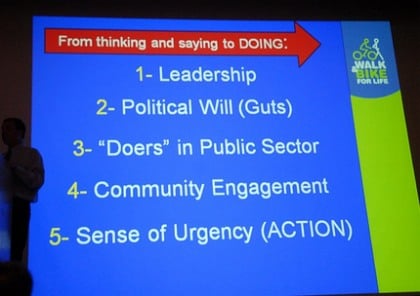
Does Portland have the “guts”, the “doers” or the sense of urgency?
— You can download the survey here (1.0 MB PDF).


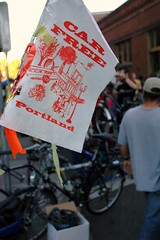
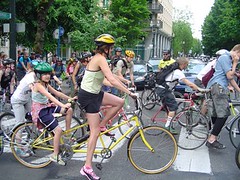
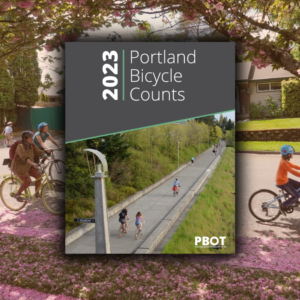
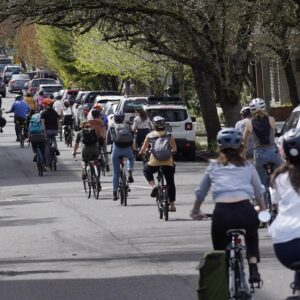
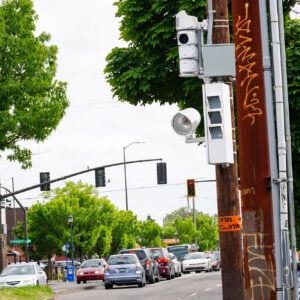

Thanks for reading.
BikePortland has served this community with independent community journalism since 2005. We rely on subscriptions from readers like you to survive. Your financial support is vital in keeping this valuable resource alive and well.
Please subscribe today to strengthen and expand our work.
It’s important to note that car-free streets, bike boulevards, etc. are truly for the people, they impact the livability and enjoyment of its citizens. This positively impacts commerce and value on the affected areas.
There are studies that suggest that overall traffic ends up being reduced when such steps are taken. This goes against the common fear (which I believe is at the core of any opposition) that this will make driving to their destinations more difficult.
The question in my mind is — what opposition is there, really? This survey shows that this is what people in the community want. The tv news crews at Sunday Parkways last summer had to work pretty hard to find one single disgruntled person — to whom they then gave a lot of bandwidth, creating the illusion of some kind of proportional unpopularity. Who doesn’t want this stuff, though? There are some radio talk show hosts whose sphere of influence is largely outside Portland proper. There are a handful of angry full-time blog commenters, ditto. There is the one guy in the pickup truck at Sunday Parkways… who else, really?
The real two sides to this issue are probably going to end up being more like “I think carfree spaces should be designed like A” vs. “No way you fool, they should be designed like B.”
I think for this survey to actually have any merit, it’s got to be offered to everyone in Portland. Putting it at community events, to me, doesn’t really survey the general population.
I don’t know what the media was doing the last Sunday Parkway, but it went through my neighborhood and my neighbors and I were all pretty much in consensus about NOT liking the event. It was great if it was something you wanted to participate in, but if you didn’t, it pretty much sucked.
Not trying to be a devil’s advocate, but I also want to make sure that assumptions aren’t being made about the people outside of the biking community.
anonymous,
one of the reasons I decided to do a story on this survey is precisely because is was offered to a lot of Portlanders. Sure, not “everyone”, but it was distributed throughout the city and at many events that have nothing at all to do with bikes.
Sorry, I didn’t realize that I was required to be anti-car as a precondition of riding a bike.
chriswnw,
not sure what you mean by that. the story above, nor the term “carfree” have anything to do with being “anti-car”.
The term “anti-car” misses the point. What is on the table are a few things:
1) Car free zones – Creating a public space the street on a negligible proportion of the current road miles. You could weakly argue that this is anti car but that would be like saying that not allowing us to drive on the esplanade or through the center of Pioneer Square or through your back yard is anti-car.
2) Creating bike boulevards – Car diverters and other mechanisms to make cycling more friendly on these sections of roads basically enforces the intent of the arterial/side road model of traffic flow. ***Motorists shouldn’t be cutting through on those roads anyway.*** When they do, it makes those areas less livable as the cut-thru drivers tend to be focused on shaving time inherently making for a dangerous situation. A bike boulevard also shifts bicycle traffic off the arterials making everyone’s journey safer and faster.
3) Bike lane improvements – While the viability of bike lanes is well debated here, it’s an odd angle to somehow consider a bike lane to be anti-car.
I agree Elly (#2) in that, in reality, there is little opposition. I would venture to guess that the only battles will be who gets the boulevard treatment and design. Given real estate values trend upward on BB streets, I certainly want one on my street. It’ll be the opposite of NIMBY, it’ll be YIMBY.
the major oppositions to doing more carfree spaces and major bikeway projects is the powerful status quo of the system…mostly encapsulated by outdated (yet still powerful) national guidelines that are strangling innovation and progress….also.. i feel there’s a real political fear to do anything in favor of the overly-politicized “bike lobby”, especially in these times of budget doom and gloom..
Thanks Jonathan for an encouraging update. And DOWN with the “anti” anything. It’s become quite clear among us, cyclists and bikeportland readers that our only “anti” refers to abuse or ideas of exclusivity when it comes to getting around the city.
Happy sunny riding, everyone.
AND in surprising note… new professional sports arenas, giant freeway superstructures, and convention hotels did not make the list!
http://www.portlandonline.com/portlandplan/index.cfm?c=46823&a=240447
ARE YOU LISTENING Mayor Sam Adams and Commissioners Randy Leonard, Nick Fish, Dan Saltzman??!
Portlanders bold vision is for affordable housing and livable streets!
I guess I’m bothered that I live in North Portland, have attended several community events (Mostly at the community centers) and never heard of nor had an opportunity to take this survey, that I’m aware of. I wonder events they were available at.
My point is that if it doesn’t have the opinion of all who would like to voice their opinion, then I feel that the results are flawed.
Anonymous,
locations and events where it was distributed are on page three of the PDF I link to in the story.
also, I would say the results are “flawed”.. they are just what they are. we are smart enough to know they are not a perfect representation of the City as a whole, but they are still a representation of something.
Anonymous,
locations and events where it was distributed are on page three of the PDF I link to in the story.
also, I would not say the results are “flawed”.. they are just what they are. we (all of us) are smart enough to know they are not a perfect representation of the City, but they are still a representation of something.
I like the bike boulevards, but they aren’t car-free. People still drive on them for local access to the neighborhoods. I don’t consider this to be problematic, as the cars generally restrict themselves to 25 mph. I don’t feel that my biking experience would be drastically improved if there were one or two token streets with absolutely zero cars on it, and I am not sure what purpose it would accomplish (aside from self-congratulation or civic boosterism).
I’m not a huge fan of bike lanes — I prefer sharrows, and making sure that there are a sufficient number of 30 mph streets with wide outside lanes or 25 mph residential streets that get cyclists where they want to go. Bike lanes often lead through the door zone and fill up with debris.
Anonymous –
If I were to guess what happen, there was a both or people handing out flier about the survey. You saw these people and avoided them because you thought they were selling something or pushing something that you weren’t interested in. We all do it from time to to, some of us more than others.
I have also gone to events and missed things that my friends noticed and I wonder why. This is usually the case. This is the same when people come door to door and you don’t answer your door because you don’t want to hear another sales pitch. At some point in time we all have to take responsibility for missing out on things.
elly – I would have to disagree with you. There are plenty of people that don’t want this. They just don’t go to community events or have choose to move to the burbs because they don’t like the intercity. The question then becomes do we care because they don’t socialize or have moved away from what they don’t like. The liberal would say, yes we do care and need to understand why they don’t socialize or moved. The conservative would say we don’t because they have chosen not to be part of the community and part of the process.
Shane, I guess I wonder how much of what people want in any given moment is a result of what information they’re getting and the tools they have available to interpret it. You could ask the same person if they want a bike boulevard in front of their house and if they want to live on a quiet street where their kids can play outside and get two very different answers, unless that person has spent some time learning and thinking about the underlying issues.
You can’t have an informed public unless you inform the public.
Wow shane, thanks for “guessing” about my actions. I always answer my door, and I don’t turn down people that are trying to talk to me at an event.
Anon., what about Children International and Greenpeace activists that are on every corner downtown? Do you talk to them? That’s the point I believe shane was making.
The graphic looks like underwear.
Happy cycling !
I suspect the opposition will emerge not to the warm and fuzzy general principles noted here but when it comes to specific hard choices like taking out a traffic or parking lane. Then you’ll see letters to the Oregonian claiming that if Portland makes it harder for suburbanites to drive into downtown (like by raising parking fees, shortening meter times, taking out car lanes, slowing down traffic, etc etc), why, they’ll just drive to the mall and its abundant parking instead. Some retailers will insist that they need parking places right in front of t heir stores. Etc. etc.
Of course, they’re wrong and shortsighted. In fact, experience shows that reducing auto centric policies and making streets people friendly actually attracts activity and business, because they invite people to come down and shop, eat out, go to entertainment events, etc. in a relaxing setting.
I completely agree with Jonathan, and as we learned at the Carfree Cities conference, making the streets safe and welcoming for walkers and bike riders can boost the liveliness and economy of livable cities, not to mention reducing infrastructure and environmental costs.
Portland is luckier than most American cities in that we resisted much (though certainly not all) of the catastrophic midcentury transformation of vital cities into car transportation zones. Most of our central city area is easily walkable and bikeable. Cities like Vancouver BC that entirely fended off inner city highways are doing great because they’re walkable and livable and don’t privilege cars over people.
Making downtown and inner city neighborhood nodes more easily accessible by bike, walking, and public transportation, and reducing the intimidating factor of cars and infrastructure designed for them, will boost local businesses and quality of life. But don’t expect interests with a stake in the discredited car-centric economy to embrace those changes. And don’t expect ignorant people who’ve spent their adult lives driving and parking everywhere, and who believe everything they hear from certain talk shows, to understand why bike and ped-friendly changes benefit the whole community. It’s going to take some educational outreach to show everyone how much more inviting the city can be when we stop putting cars before people. Surveys like this one may be a good step in that direction.
I think these results tell us that people who actually live in the city are getting real tired of being bullied by suburbanites in their motor vehicles when they are out walking or biking on city streets.
GLV –
Well, for the most part, I at least let them tell me who they are and what they are about. I already have a child in Children international though.. his name is Hector!
Elly – you didn’t say informed public. A majority of the public is uninformed. We only hear what we want to hear, and we only know what we heard. I don’t disagree with this plan and hope that it becomes reality. I was just disagreeing with you about there not being any opposition. I talk with people all the time that disagree with the move away from cars. They will never hear all the facts.
Anonymous – I wasn’t trying to offend you, just stating that it is easy to miss things of this nature. We all do it. In the print world it is called being “Poster Blind”. When posters first came out, people noticed them all the time. Now people often don’t give a second glance at posters. In this case, Oregon has a ton of ’causes’ and people going around for these causes. After a while people learn how to avoided these people without even knowing it.
I don’t know that a location’s popularity has anything to do with its care-free-ness. Eugene blocked off traffic in its “downtown mall” area for a number of years, and the place became a haven for stoners and street kids. Many of the store fronts were deserted, and people who weren’t actively seeking out drugs didn’t spend much time there. Most people satisfied their shopping needs at the suburban Valley River Center mall or big box stores. Eventually, they put the street back in. I was in favor of it, as I was able to bike through.
While this is, I guess, somewhat encouraging, I don’t know how much it really matters. It’s easy enough for people to say “oh yeah, I’m for more bikeways and car-free spaces” in the abstract, harder to apply that thinking to specific streets. That’s where the rubber meets the road, so to speak. I’d be more encouraged if a local merchants association or local neighborhood group or homeowners groups or something similar in a specific neighborhood went to the city planners and said “We want these blocks here to be car-free. How can we make this happen?”
Too much of Portland planning is top-down. The Rose Quarter (a.k.a. the Dead Zone) is an example of the downside of that: enormous, anti-urban, monolithic structures that kill off any sense of neighborhood or any human-scale development.
The reasons for the failure of Eugene’s downtown are many and much debated. A lot has to do with the ill considered urban removal that destroyed the old pedestrian friendly Eugene downtown and replaced it with little used parking garages.
I lived in Eugene before and after auto traffic was restored. The hulking parking garages are still there, sucking the vitality from downtown. It’s been what, seven or eight years since the car traffic came back? How’s that working? Downtown Eugene is as desolate as ever. So cars aren’t the answer.
The same philosophy also devastated Portland’s south auditorium district, but thanks to a lot of dedicated effort was stopped before it ruined the rest of downtown. The areas to the west (Broadway through 11th st, say) are a lot more vital and active than the car friendlier urban renewal area. Today thousands of people crowded Pioneer Square, which was slated to be a parking garage. Which is better for the city?
Besides, I don’t think Jonathan’s necessarily talking about the Eugene kind of car limitation. You can find plenty of examples of more vital car limited, pedestrian friendly areas around the world.
A lot of factors — sprawl, growth planning (Eugene’s UGB was made way too big, to downtown’s detriment) and other land use policies, etc — go into urban vitality. Bikeability and pedestrian friendliness are a big part of the answer, but not the whole answer, nor are they responsible for downtown declines.
True, downtown Eugene still doesn’t have much going for it. I thought they should have zoned the area to allow both residential and commercial, and just allow it to turn into another neighborhood. Planners seem to still be far too influenced by Robert Moses, with their stadiums, convention centers, auditoriums, malls, and other things that aren’t really pertinent to having a functional and enjoyable neighborhood.
There’s dumb carfree, and then there’s smart carfree. Looks like Eugene was one of the former. Church Street in Burlington, Vermont, where I lived for seven years, was and still is a successful carfree street.
The important thing is to make the experiences varied and involving. Parking garages adjacent to the walking space suck the life out of an area. Large stores with few windows do the same. Spaces that are too open, too closed-in, or too uniform are also bad. Most of downtown Portland is already well suited to this kind of thing, as long as the little details are handled well, which is not a guarantee.
most of downtown portland is fine as it is for cyclists and pedestrians.
I think that first of all, the opposition doesn’t necessarily come from individuals, but from groups including freight, business owners (like the ones who trounced bike lanes on Hawthorne), and most importantly the media (as Jonathan demonstrated in his article). Reducing auto control is something that everyone would love if they could experience it for a few months. But unfortunately this isn’t something that can be put in place quickly to try out. It takes years of public input and planning before something can happen. And since it represents a drastic change from the established norm, people will by default be wary.
The most successful model I’ve seen is limiting visibility to reduce traffic. I didn’t find a great example, but simply by making streets more serpentine, drivers have to be more attentive and slow. This would do more to heal the rift than banning cars altogether.